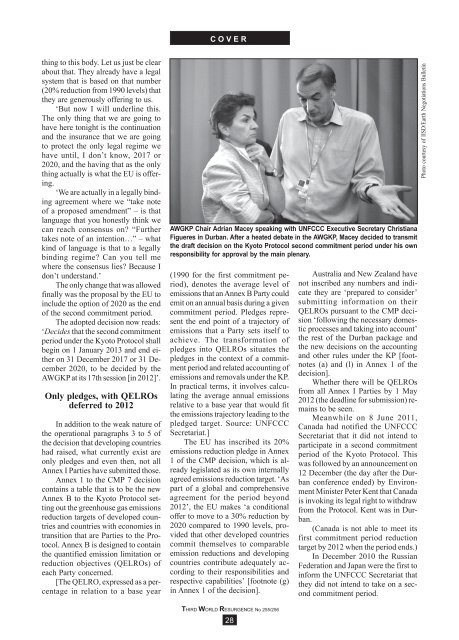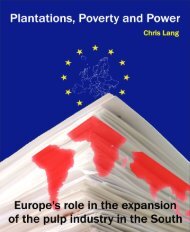C O V E Rmunicated by them … and of the intentionof these Parties to convertthese targets to quantified emissionlimitation or reduction objectives(QELROs) for the second commitmentperiod under the Kyoto Protocol’;Para 5: ‘Invites Parties includedin Annex I listed in Annex 1 to thisdecision to submit information ontheir QELROs for the second commitmentperiod under the Kyoto Protocolby 1 May 2012 for considerationby’ the AWGKP in its 17th session in2012.Other Parties including Venezuelaand Saudi Arabia also spokestrongly on the weakness of theseparagraphs as a way forward for theKP.Bolivia also pointed out theweakness of preambular paragraph 9that states, ‘Aiming to ensure that aggregateemissions of greenhousegases by Parties included in Annex Iare reduced by at least 25-40% below1990 levels by 2020 …’It expressed concern that thisrange (25-40%) is too big; it does notgive a clear answer of how much ofthe greenhouse gases should be reducedfor the next years. What isneeded are single numbers of intentionof how much reduction will bemade, Bolivia said.Kenya proposed the insertion inpreambular paragraph 8 of the words:‘to ensure no gap between the first andsecond commitment periods of theKP’. It asked for replacement ofpreambular paragraph 9 with ‘Reaffirmingthat immediate action shall betaken by Annex I Parties to ensure thatthe emissions reduction commitmentsare science-based and sufficient tocontribute in an equitable manner towardslimiting the global averagetemperature increase to well belowbelow 1.5 degrees Centigrade aboveindustrial levels in a time frame thatprotects the ecosystem, food productionand sustainable development’.It concurred with those whofound the language in paragraphs 3,4, 5 and 6 to be weak. It also proposedparagraph 6bis: ‘Decides that the secondcommitment period shall applyto all Parties immediately upon theconclusion of the first commitmentperiod … and shall apply on a provisionalbasis until entry into force ofthe amendment of each Party’.Nicaragua made several proposalsthat it repeated at the CMP 7 finalplenary (see below).The European Union made threeamendment proposals. The first wasto include the option of ending thesecond commitment period in 2020(Macey’s text stated 2017) and thiswas accepted even though severalcountries including Grenada, Bolivia,Gambia, Kenya and Colombia hadspoken against the change.Connie Hedegaard, the EU’s ClimateChange Commissioner, said ithad been raised in the ministerial consultationsand that there is a generalunderstanding that there has to be asymmetry between what is done in theKP and the LCA (long-term cooperativeaction under the UNFCCC thatis addressed by a separate ad hocworking group), and so it must be2020.(The year 2020 relates to the decisionsubsequently adopted by theUNFCCC COP on a new process ofnegotiations to commence work in thefirst half of 2012 and to be completedno later than 2015 in order for theadoption of a protocol, another legalinstrument or agreed outcome with legalforce under the Convention, applicableto all Parties, in 2015 and forit to come into effect and be implementedfrom 2020.)The EU’s other proposed amendmentswere to delete part of a paragraphrelating to units acquired fromemissions trading under Article 17 ofthe KP and to include a paragraph onland use, land-use change and forestry.Japan and the Russian Federationalso had proposals for amendments.Saudi Arabia had some proposalsbut the Chair did not allow thedelegate to proceed, stating that ‘wehave passed the time for amendments.Any amendments that Parties reallywant to propose will have to be donein the plenary’.When Saudi Arabia retorted thatthe Chair had accepted from otherParties proposals that went into brackets(referring to the EU), the Chairresponded by saying that he had notaccepted proposals from other Parties.‘They were read out quickly. I listento other proposals. It is unlikely thatany of the proposals can achieve consensusand that remains my view. Weare past the stage to listen to long listsof amendments,’ Macey said.‘Can you explain pleasewhat stage of democracyin this process we arein?’ – Venezuelandelegate Claudia SalernoCalderaVenezuela’s climate envoy,Claudia Salerno Caldera, intervenedat this stage and asked for some clarityon the procedures. ‘I have beenvery patient in this room listening todeveloped countries putting ideas forward,on bracket ideas put forward,and actually anchoring their low levelsof ambition, and then developingcountryParties are not allowed to talkabout what they think about this futurewe are heading to. I have seenyou give [time for consideration oftheir positions] to developed-countryParties. So can you explain pleasewhat stage of democracy in this processwe are in?’ she asked, to applausein the hall.The EU’s Hedegaard respondedthat everybody will know the EU willnot give empty pledges. ‘I think thatit will be hard to find anyone here withall their pledges as ambitious as ournational leg. We are very much ready,and that is also in the text, still to havea 30% proposal on the table. It is notthat the commitment period is emptybecause of the EU. We are actuallyone of the few ones who will be inthe second commitment period. It isfair to state that.’To that, Venezuela said, ‘To bevery frank, the only thing that we arehaving from the EU is actually whatthey already have in their national legislation,so they are not offering any-THIRD WORLD RESURGENCE No 255/25627
C O V E Rthing to this body. Let us just be clearabout that. They already have a legalsystem that is based on that number(20% reduction from 1990 levels) thatthey are generously offering to us.‘But now I will underline this.The only thing that we are going tohave here tonight is the continuationand the insurance that we are goingto protect the only legal regime wehave until, I don’t know, 2017 or2020, and the having that as the onlything actually is what the EU is offering.‘We are actually in a legally bindingagreement where we “take noteof a proposed amendment” – is thatlanguage that you honestly think wecan reach consensus on? “Furthertakes note of an intention…” – whatkind of language is that to a legallybinding regime? Can you tell mewhere the consensus lies? Because Idon’t understand.’The only change that was allowedfinally was the proposal by the EU toinclude the option of 2020 as the endof the second commitment period.The adopted decision now reads:‘Decides that the second commitmentperiod under the Kyoto Protocol shallbegin on 1 January 2013 and end eitheron 31 December 2017 or 31 December2020, to be decided by theAWGKP at its 17th session [in 2012]’.Only pledges, with QELROsdeferred to 2012In addition to the weak nature ofthe operational paragraphs 3 to 5 ofthe decision that developing countrieshad raised, what currently exist areonly pledges and even then, not allAnnex I Parties have submitted those.Annex 1 to the CMP 7 decisioncontains a table that is to be the newAnnex B to the Kyoto Protocol settingout the greenhouse gas emissionsreduction targets of developed countriesand countries with economies intransition that are Parties to the Protocol.Annex B is designed to containthe quantified emission limitation orreduction objectives (QELROs) ofeach Party concerned.[The QELRO, expressed as a percentagein relation to a base yearAWGKP Chair Adrian Macey speaking with UNFCCC Executive Secretary ChristianaFigueres in Durban. After a heated debate in the AWGKP, Macey decided to transmitthe draft decision on the Kyoto Protocol second commitment period under his ownresponsibility for approval by the main plenary.(1990 for the first commitment period),denotes the average level ofemissions that an Annex B Party couldemit on an annual basis during a givencommitment period. Pledges representthe end point of a trajectory ofemissions that a Party sets itself toachieve. The transformation ofpledges into QELROs situates thepledges in the context of a commitmentperiod and related accounting ofemissions and removals under the KP.In practical terms, it involves calculatingthe average annual emissionsrelative to a base year that would fitthe emissions trajectory leading to thepledged target. Source: UNFCCCSecretariat.]The EU has inscribed its 20%emissions reduction pledge in Annex1 of the CMP decision, which is alreadylegislated as its own internallyagreed emissions reduction target. ‘Aspart of a global and comprehensiveagreement for the period beyond2012’, the EU makes ‘a conditionaloffer to move to a 30% reduction by2020 compared to 1990 levels, providedthat other developed countriescommit themselves to comparableemission reductions and developingcountries contribute adequately accordingto their responsibilities andrespective capabilities’ [footnote (g)in Annex 1 of the decision].Australia and New Zealand havenot inscribed any numbers and indicatethey are ‘prepared to consider’submitting information on theirQELROs pursuant to the CMP decision‘following the necessary domesticprocesses and taking into account’the rest of the Durban package andthe new decisions on the accountingand other rules under the KP [footnotes(a) and (l) in Annex 1 of thedecision].Whether there will be QELROsfrom all Annex I Parties by 1 May2012 (the deadline for submission) remainsto be seen.Meanwhile on 8 June 2011,Canada had notified the UNFCCCSecretariat that it did not intend toparticipate in a second commitmentperiod of the Kyoto Protocol. Thiswas followed by an announcement on12 December (the day after the Durbanconference ended) by EnvironmentMinister Peter Kent that Canadais invoking its legal right to withdrawfrom the Protocol. Kent was in Durban.(Canada is not able to meet itsfirst commitment period reductiontarget by 2012 when the period ends.)In December 2010 the RussianFederation and Japan were the first toinform the UNFCCC Secretariat thatthey did not intend to take on a secondcommitment period.Photo courtesy of IISD/Earth Negotiations BulletinTHIRD WORLD RESURGENCE No 255/25628















